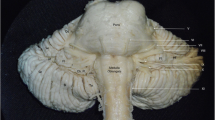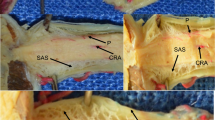Summary
In adult men, 41 out of 47 preparations examined showed a terminal ramification of the pial blood-vessels in the region of the cisterna cerebellomedullaris.
The subarachnoid branches of these vessels form a circumscribed terminal circulatory system (capillary loops and network) on the pial surface of the arachnoid or in the subarachnoid membranes.
The capillary loops are either lateral branches of arteries (short loops, group I), or rectilinear continuations of arteries (long loops, group II). In most cases there are no arterioles.
Quite often a constriction — due to a thickening of the wallis observed at the origin of the capillary net and the group I loops. Occasionally circular fibres with transverselly oval nuclei are encountered (Sphincter ?).
All blood-vessels of the subarachnoid cavum are covered with a lamellar perivascular sheath, which is lined with mesothelium. This sheath separates blood-vessels from the cerebrospinal fluid. Its possible rôle as a barrier is pointed out.
Perivascular cell groups are found at the venous limb of the group I loops and the capillary nets. Their relation to the arachnoid, and the perivascular sheath, is discussed. In the terminal part of the subarachnoid vessels, the lumen of undulating veins becomes narrowed down through a thickening of the perivascular sheath. This phenomenon is not observed in undulating arteries.
These results are compared with those of other investigators. In some points they do not agree with the classical concept of the terminal circulatory system. They seem to be much more in agreement with modern theories of vascularisation.
Zusammenfassung
In der Cisterna cerebellomedullaris des erwachsenen Menschen kommen Endausbreitungen der Piagefäße vor. Sie waren an 41 von insgesamt 47 untersuchten Präparaten vorhanden.
Die subarachnoidalen Äste der Piagefäße bilden an der pialen Fläche der Arachnoidea oder an den subarachnoidalen Häutchen umschriebene terminale Strombahnen mit Capillarschlingen und Capillarnetzen.
Die Schlingencapillaren gehen entweder als Seitenäste aus Arterien ab (kurze Gefäß-schlingen, Gruppe I) oder sie sind geradlinige Fortsetzungen der Arterien (lange Gefäßschlingen, Gruppe II). Die Zwischenstufe der Arteriolen fehlt meist.
Die Schlingencapillaren der Gruppe I und die Netzcapillaren sind an ihrem Ursprung oft eingeengt. Ihre Wand ist an diesen Stellen verdickt. Zuweilen ist eine circuläre Faserung mit quergestellten ovalen Kernen vorhanden (Sphincter ?).
Alle Blutgefäße des Cavum subarachnoidale umhüllt eine lamelläre, mit einem Mesothelüberzug ausgestattete, perivasculäre Scheide. Sie trennt sie vom Liquor cerebrospinalis. Auf ihre mögliche Bedeutung als Barriere wird hingewiesen.
Am venösen Schenkel der Schlingecapillaren der Gruppe I und am venösen Teil der Capillarnetze liegen perivasculäre Zellhaufen. Ihre Beziehungen zur Arachnoidea, zur perivasculären Scheide, wird erörtert.
Die Lichtung gewellter Venen der terminalen subarachnoidalen Gefäßstrecke wird durch Verdickungen der perivasculären Scheide eingeengt. An gewellten Arterien sind derartige Einengungen nicht vorhanden.
Diesen Ergebnissen werden vergleichbare anderer Autoren gegenübergestellt. In einigen Punkten lassen sie sich nicht mit dem klassischen Bild der terminalen Strombahn vereinbaren. Sie scheinen vielmehr eine moderne Gefäßtheorie zu stützen.
Similar content being viewed by others
Literatur
Bargmann, W.: Über die Endomeninx der Fische (Zugleich ein Beitrag zur Kenntnis der Turbanorgane). Z. Zellforsch. 40, 88–100 (1954).
— Histologie und mikroskopische Anatomie des Menschen, 5. Aufl. Stuttgart: Georg Thieme 1964.
Chambers, R., and B. W. Zweifach: Topography and function of the mesenteric capillary circulation. Amer. J. Anat. 75, 173–205 (1944).
Clara, M.: Das Nervensystem des Menschen. Ein Lehrbuch für Studierende und Ärzte, 3. Aufl. Leipzig: Johann Ambrosius Barth 1959.
Dabelow, A.: Die Blutversorgung der lymphatischen Organe. Verh. anat. Ges. (Jena) 179–224 (1938).
Elze, C.: In: H. Braus, Anatomie des Menschen, 3. Aufl., Bd. II. Berlin-Göttingen-Heidelberg: Springer 1956.
Hackenberg, P.: Die Bindegewebsstrukturen der Leptomeninx cerebri beim Menschen, ihre Beziehungen zu Gefäßen und Hirnnerven. Anat. Anz. 110, 336–347 (1962).
Hammersen, F.: The capillary bed of the renal fibrous capsule. A contribution to the problems in blood vessels analysis in the terminal vascular bed. Angiology 12, 511–516 (1961);
— u. J. Staubesand: Über die Stromwege in der Nierenkapsel von Mensch und Hund. zugleich ein Beitrag zum Begriff der arterio-venösen Anastomosen. Angioarchitektonische Studien an der Niere. III. Mitt. Z. Anat. Entwickl.-Gesch. 122, 263–381 (1961).
Hayek, H. v.: Über arterio-venöse Anastomosen und die postcapillaren Venen der menschlichen Tonsille. Z. Anat. Entwickl.-Gesch. 111, 533–544 (1942).
Howarth, F., and E. R. A. Cooper: The fate of certain foreign colloids and crystalloids after subarachnoid injection. Acta anat. (Basel) 25, 112–140 (1955).
Illig, L.: Die Kreislaufmikroskopie am Mesenterium und Pankreas des lebenden Kaninchens. (Ein kritischer und technischer Beitrag zur Methodik der subjektiven Beobachtung und Photographie der terminalen Strombahn am Säugetier.) Z. ges. exp. Med. 126, 249–277 (1955).
— Capillar „Kontraktilität“, Capillar „Sphincter“ und „Zentralkanäle“ (a. v. Bridges). Klin. Wschr. 35, 7–22 (1957).
— Die terminale Strombahn. Capillarbett und Mikrozirkulation. In: Pathologie und Klinik in Einzeldarstellungen, Bd. X. Berlin-Göttingen-Heidelberg: Springer 1961.
— Grundsätzliches über Bau, Funktion und Störungen der terminalen Strombahn. Dtsch. zahnärztl. Z 19, 165–177 (1964).
Key, F., u. G. Retzius: Studien in der Anatomie des Nervensystems und des Bindegewebes. Stockholm: Samson & Wallin 1875.
Kiss, F.: Zitiert nach Rusznyák usw.
Lang, J.: Über eigenartige Kapillarkonvolute der Pleura paritealis. Z. Zellforsch. 58, 487–523 (1962).
Mattick, F.: Zur Biologie des Knorpels. Verh. anat. Ges. (Jena) 78–85 (1951).
Petersen, H.: Histologie und mikroskopische Anatomie. München: J. F. Bergmann 1935.
Romeis, B.: Mikroskopische Technik, XV. Aufl. München: Leibniz 1948.
Rusznyák, J., M. Földi u. Gy. Szabó: Physiologie und Pathologie des Lymphkreislaufs. Jena: Gustav Fischer 1957.
Schaltenbrand, G.: Plexus und Meningen. In: Handbuch der mikroskopischen Anatomie des Menschen, Bd. IV/2. Berlin-Göttingen-Heidelberg: Springer 1955.
Scharenberg, K.: Die Nerven und das Bindegewebe der Pia des Menschen im mikrophotographischen Bild. Acta neuroveg. (Wien) 20, 97–108 (1960).
— Die Nerven und das Bindegewebe der Pia des Menschen im mikrophotographischen Bild. Acta neuroveg. (Wien) 17, 278–293 (1958).
Schefthaler, M., u. A. Mayet: Eine Modifikation der Bielschowsky-Methode für periphere Nerven. Mikroskopie 12, 298–301 (1958).
Schultz, A., u. H. J. Knibbe: Neue Erkenntnisse über die normale und pathologische Histologie der weichen Hirnhäute durch die Untersuchung an „Häutchenpräparaten“. Teil I. Normale Anatomie und funktionelle Reaktionen. Frankfurt Z. Path. 63, 455–471 (1952).
Spalteholz, W.: Über die „Endarterien“. Eine historisch-kritische Studie. Ergebn. Anat. Entwickl.-Gesch. 33, 21–30 (1941).
Spanner, R.: Neue Befunde über die Blutwege der Darmwand und ihre funktionelle Bedeutung. Gegenbaurs morph. Jb. 69, 394–454 (1932).
Ssolowjew, A., u. M. B. Ariel: Zur Morphologie der weichen Hirnhäute beim Kaninchen. Z. Zellforsch. 17, 642–661 (1933).
Staubesand, J., u. F. Hammersen: Zur Problematik des Nachweises arterio-venöser Anastomosen im Injektionspräparat. Z. Anat. Entwickl.-Gesch. 119, 365–370 (1956).
Stöhr jr., Ph.: Handbuch der Histologie und der mikroskopischen Anatomie des Menschen. Berlin-Göttingen-Heidelberg: Springer 1951.
Zweifach, B. W.: The structure and reactions of the small blood vessels in Amphibia. Amer. J. Anat. 60, 473–514 (1936/37).
— The character and distributions of the blood capillaries. Anat. Rec. 73, 475–495 (1939).
— Direct observation of the mesenteric circulation in experimental animals. Anat. Rec. 120, 277–288 (1954).
Author information
Authors and Affiliations
Additional information
Herrn Prof. Dr. Curt Elze zur Vollendung des 80. Lebensjahres.
Rights and permissions
About this article
Cite this article
Mayet, A. Subarachnoidale terminale Gefässausbreitungen in der Cisterna cerebellomedullaris des Menschen. Z.Zellforsch 66, 609–624 (1965). https://doi.org/10.1007/BF00368250
Received:
Issue Date:
DOI: https://doi.org/10.1007/BF00368250




